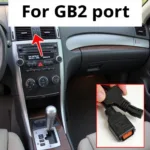The idea of running an OBD2 distributor (dizzy) on an OBD1 engine control unit (ECU) might seem intriguing, especially for those looking to upgrade their older vehicles. However, the compatibility between these two systems isn’t straightforward. This article delves into the intricacies of OBD2 and OBD1 systems, exploring whether such a setup is feasible and outlining potential challenges and solutions.
Understanding OBD1 and OBD2 Systems
Before diving into compatibility, it’s crucial to understand the fundamentals of OBD1 and OBD2 systems. OBD, or On-Board Diagnostics, refers to a vehicle’s self-diagnostic and reporting capability.
OBD1, prevalent in vehicles manufactured before 1996, utilizes a simpler system with limited diagnostic capabilities. It primarily relies on a carburetor or single-point fuel injection system, with the ECU managing ignition timing and fuel delivery based on a narrow range of sensor inputs.
OBD2, mandated for vehicles manufactured after 1996, introduced significant advancements in emissions control and diagnostics. It relies on a wider array of sensors, providing the ECU with more precise data on engine performance and emissions. This allows for more sophisticated control over ignition timing, fuel injection, and other critical engine parameters.
The Challenge: Communication Breakdown
The core challenge of using an OBD2 distributor with an OBD1 ECU lies in the communication protocols. OBD2 systems utilize a standardized communication protocol, typically CAN (Controller Area Network) or J1850, enabling seamless data exchange between the ECU and various sensors, including the distributor.
OBD1 systems, however, lack this standardized communication protocol. They rely on manufacturer-specific protocols, often using analog signals for communication. This incompatibility poses a significant hurdle in integrating an OBD2 dizzy, which communicates digitally, with an OBD1 ECU designed for analog signals.
Potential Solutions and Workarounds
While direct compatibility between an OBD2 dizzy and an OBD1 ECU is improbable, there are potential workarounds for those determined to explore this avenue:
-
Standalone Engine Management System: Replacing the factory OBD1 ECU with a standalone engine management system (EMS) provides the most comprehensive solution. Standalone EMS offer advanced tuning capabilities and support a wider range of sensors, including those found on an OBD2 distributor.
-
Signal Conversion: Another approach involves converting the digital signals from the OBD2 distributor into analog signals compatible with the OBD1 ECU. This requires specialized electronic circuitry and a deep understanding of both systems’ signal characteristics.
-
Hybrid Approach: A hybrid approach might involve retaining the OBD1 ECU for basic engine functions while using a separate controller to manage the ignition timing based on inputs from the OBD2 distributor. This method demands careful calibration to ensure harmonious operation between the two control systems.
Weighing the Benefits and Drawbacks
While these workarounds exist, it’s crucial to weigh the benefits against the drawbacks:
Benefits:
- Potentially Improved Ignition Timing: An OBD2 distributor, in conjunction with a compatible control system, might offer more precise ignition timing control compared to older OBD1 distributors.
Drawbacks:
- Complexity: Implementing any of the solutions mentioned above requires significant technical expertise, potentially exceeding the capabilities of a DIY enthusiast.
- Cost: The cost of components, such as a standalone EMS or signal conversion equipment, coupled with the potential labor costs for professional installation, can be substantial.
- Compatibility Issues: Even with workarounds, achieving seamless compatibility between an OBD2 dizzy and an OBD1 system can be challenging and might require extensive trial and error.
Conclusion
While the concept of running an OBD2 distributor on an OBD1 ECU might seem appealing, the inherent communication incompatibility poses a significant challenge. While workarounds exist, they often demand advanced technical skills and can be costly. Before embarking on this endeavor, carefully assess your goals, technical capabilities, and budget.
FAQs
Can I just plug an OBD2 dizzy into an OBD1 car?
Unfortunately, no. The different communication protocols between OBD2 and OBD1 systems make them inherently incompatible.
Is it worth upgrading my OBD1 system to OBD2?
Upgrading to OBD2 is a complex process and might not be cost-effective for older vehicles. However, it can offer benefits in terms of diagnostics and emissions control.
What are some alternative upgrades for my OBD1 ignition system?
Consider options like performance distributors compatible with your OBD1 system or exploring ignition timing adjustments within your existing setup.
Need further assistance with your OBD2 or OBD1 system?
Contact our expert team via WhatsApp at +1(641)206-8880 or email us at [email protected]. We’re available 24/7 to provide you with personalized support.
Looking for more insights into OBD2 scanners and automotive technology?
Check out our related articles on OBD2 HUM devices, Verizon HUMX OBD2 readers, and troubleshooting Verizon HUM problems with an OBD2 scanner. You can also learn more about HUM OBD2 speed tracking and situations where a Hummer might reject an OBD2 scanner.


